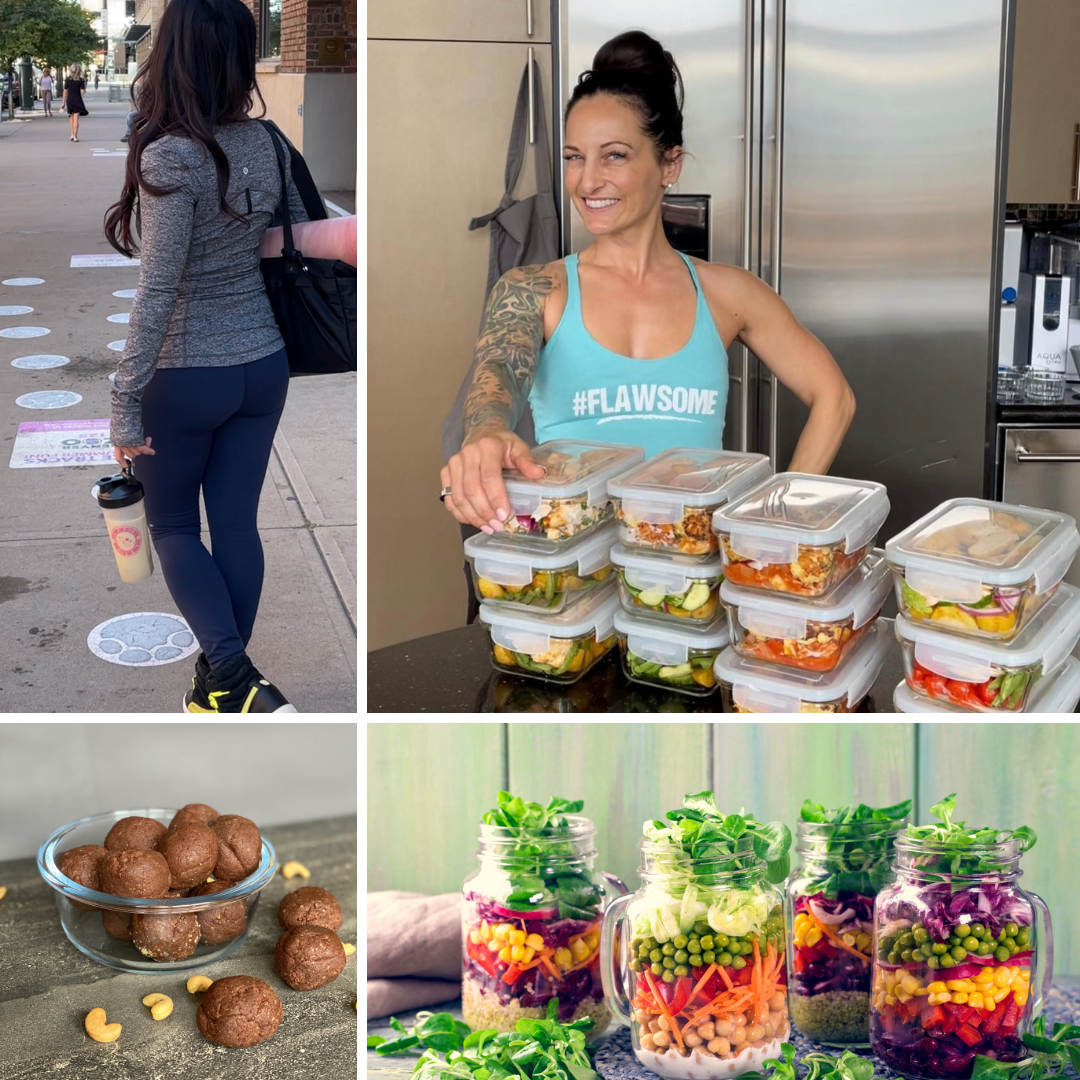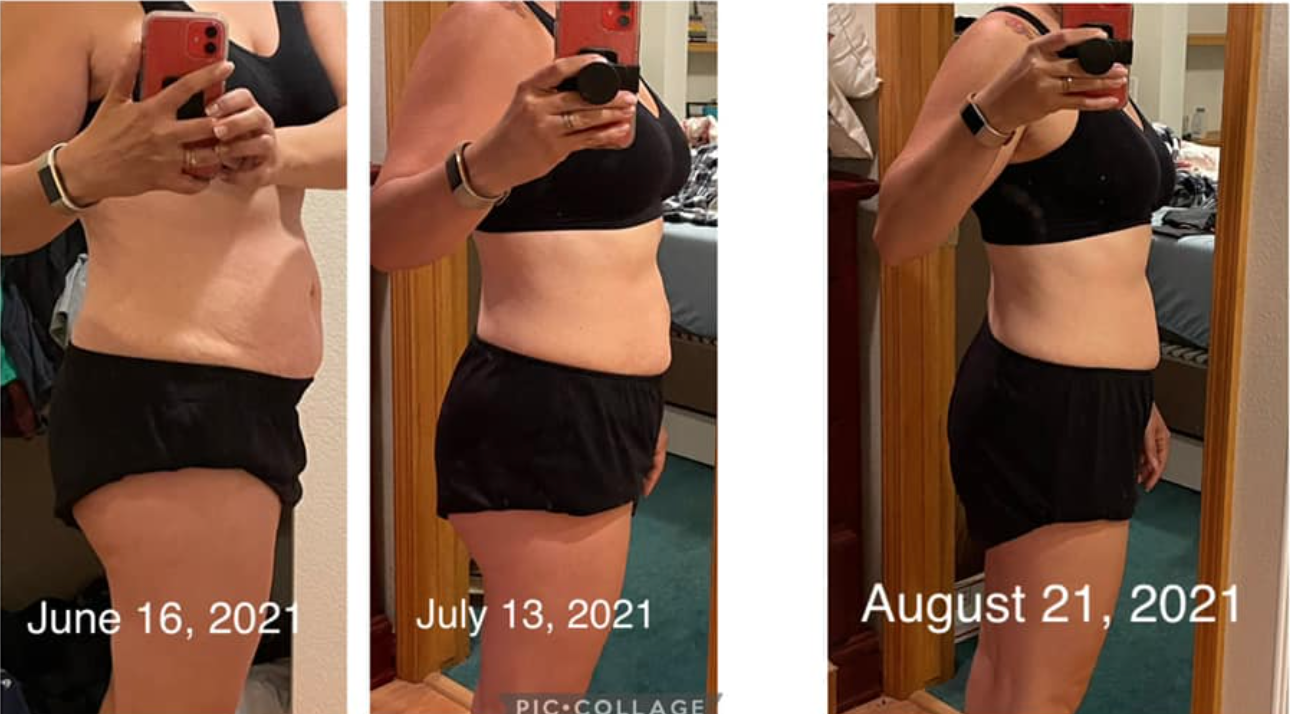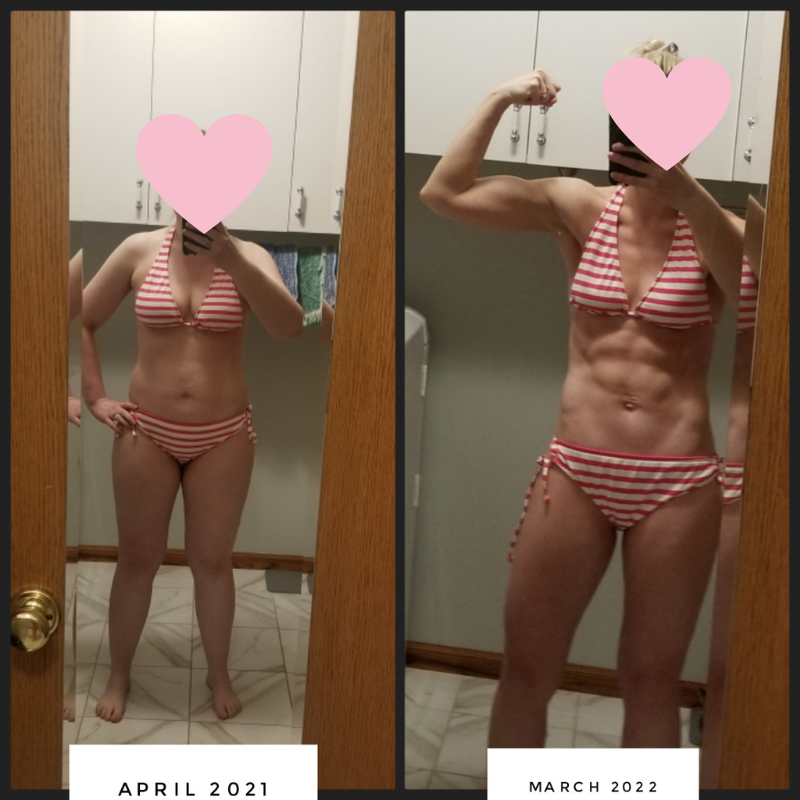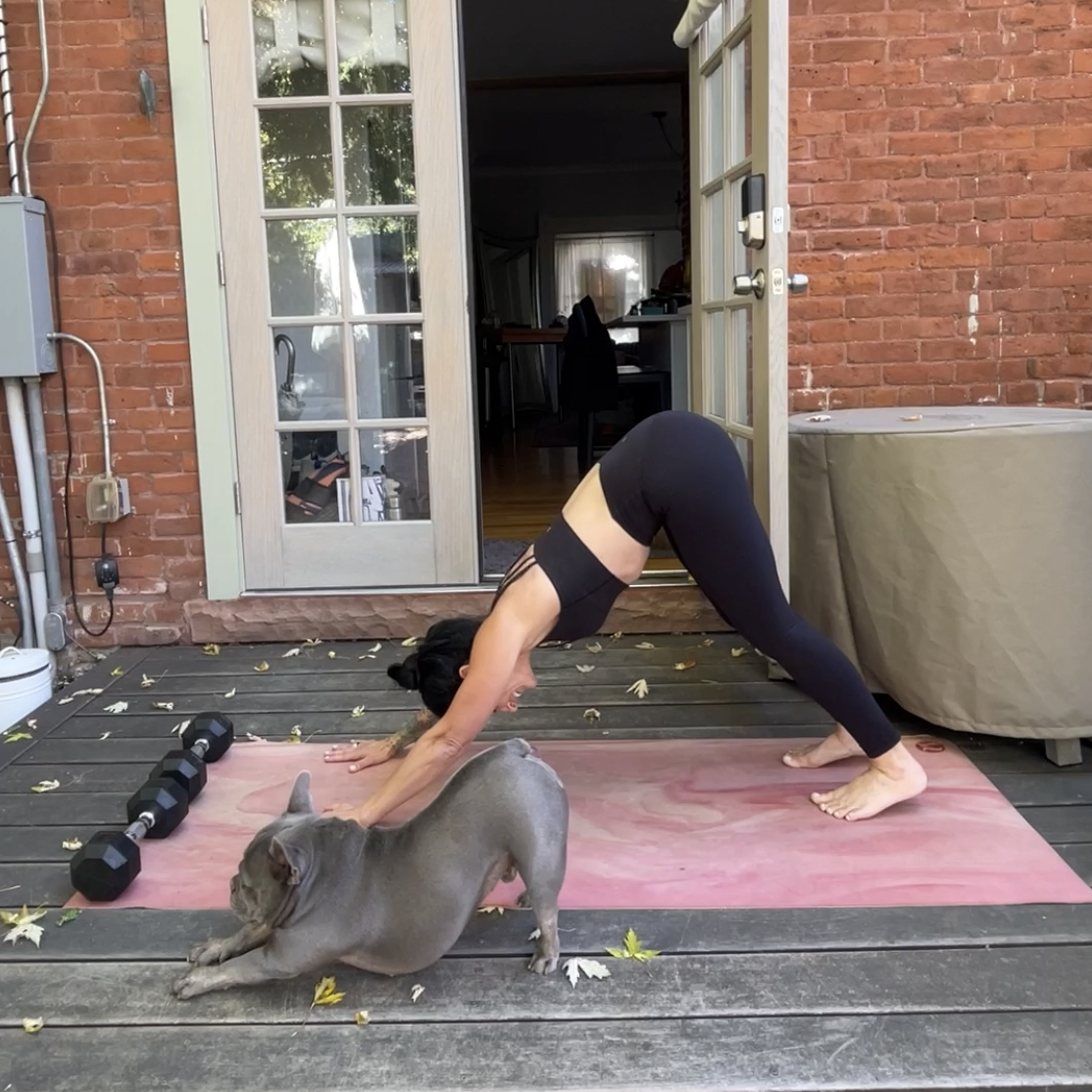Perimenopause may feel like it “creeps up on you” in your 40’s, and makes you feel like the things you did before “don’t work the same anymore.” This is true – it is a transition! And it’s something to know about and work with so you can make the best of this unique time in your life.
Your hormone cycles are shifting, your body is responding differently to your training and nutrient intake – but you can navigate it and continue to build strength and vitality with the information and tips I have for you in this article.
During perimenopause, the fluctuation between two key hormones – estrogen and progesterone – are no longer running on their regularly scheduled cycle. When you were in your regular cycling years, they had a symbiotic balancing relationship with each other and impacted your body in many different ways.
To understand where we are in perimenopause, it’s helpful to take a look at our regular cycle, illustrated below:
From your period to ovulation (follicular phase), you had more estrogen in your system – which meant you were more able to build muscle, recover more easily, and got better sleep.
From ovulation to your period (luteal phase), progesterone levels surged, and raised your basal body temperature slightly, increased inflammatory markers and may have made sleep a little less deep for a couple of weeks, elevated your hunger and impacted your mood.
But at some point in our lives, approximately 5 years before menopause (though this can really vary) our cycle starts to sputter and slow down.
As you can see below, the fluctuations in the purple (progesterone) and orange (estrogen) lines are not the same even tempo as before. And this impacts how you feel and how your body responds.

Estrogen and progesterone affect our body in so many ways, and the disruption to the regular amounts of them in your system is a big part of the symptoms you may start to notice like:
- hot flashes
- poor sleep
- mood imbalances (higher anxiety, more instances of depression)
- weight gain
- muscle and bone density loss.
Some of these symptoms can be addressed and mitigated by working with your doctor to test your hormone levels and use some type of hormone replacement therapy (HRT) to ease the transition symptoms. Adding back some of the hormones you are losing access to can help relieve some of the discomfort.
Adaptogenic herbs are also promising for supporting the body’s stress response and supporting, and in some cases helping to balance hormone levels. You might enjoy the article I wrote where I feature six adaptogenic herbs and go over their properties. You can also look into supplements like DHEA, a commonly available supplement that supports your body as a precursor to testosterone and estrogen (I recommend working with a doctor on dosing and if this is appropriate for you).
This is just scratching the surface of that conversation, and like anything you’re ingesting that can potentially alter your body’s chemistry it’s important to have the data from your hormone tests and work with a practitioner to make adjustments over time, as it’s unlikely you’ll stay in the exact same place.
Stress levels are important to pay attention to, as constant stress can impact our HPA (hypothalimic-pituitary-adrenal) axis. This is how the body regulates our hormone balance in response to stress, and can increase the levels of cortisol in our system causing more fat storage and muscle breakdown. Be mindful of your caffeine consumption and stay hydrated.
Getting more residual movement in throughout the day (like walking) is a piece that will help with fat loss. Low impact movement is a big part of our overall daily energy expenditure and walking and moving more is a supportive piece of your long-term health and self care.

You could consider developing a “walk after eating” practice where you go for a 10-15 minute walk after dinner (or any meal, but if you are at work during lunch or too busy at breakfast, dinner might be the best time to make it a habit). Walking after eating has the added benefit of supporting digestion and regulating your blood sugar (which means it’s easier to lose body fat).
I got very committed to walking more as I hit perimenopause myself. While I get to walk my dog as a regular practice, during my busy work day I wanted to figure out how I could walk for a bit after lunch so I got a simple compact stepper device that I walk on at night now sometimes too while watching a show. If you can’t get a fancy “walking desk” at work and your time is limited, you might consider something portable and compact for your job as well if it makes sense.
Developing more proactive self care practices may not sound like the fast track to fitness in perimenopause, but I can assure you it is an essential component.
Understanding that the body is changing and that we won’t “bounce back” as quickly from an injury, or build strength as quickly has made me personally really think about self care and consistency.
As the E2 (estradiol) estrogen really gave us the edge in muscle adaptations and resilience starts to wane, I have embraced the pieces of my training that I used to sometimes skip like warming up, cooling down, stretching more and really leaning into my yoga practice (fortunately I have a helper for that lol!).
When it comes to our training this is the part that I hear so many women saying “I’m exercising more, but it’s not having the same effect that it used to!” They’re gaining weight and finding they can’t get it off the way they used to, which is understandably frustrating.
The most common mistake I see is women training more and eating less – which has the opposite effect to what they’re hoping. It leaves them depleted, tired and in a greater muscle breakdown state that the body can’t repair or recover from effectively.
Remember: when you are exercising, you are creating an inflammatory response that the body then repairs from after your workout (when you refuel and rest). You are breaking down muscle when you exercise, creating micro tears in the tissue. During our recovery period, we can impact the rebuild and synthesis of new tissue by eating the right food and giving our body time to repair.
Training too much contributes to more inflammation in your body as the body tries to keep up with the repair from your workouts with less fuel – causing more muscle breakdown and more fat storage.
My advice is to shift the tempo and type of training you are doing to support more muscular adaptations. What I mean by that is make your workouts more challenging when you do them, then rest and fuel more intentionally around them (I’ll give you a schedule below).
Why focus on muscle (and not just fat loss)?
Muscle tissue is more compact and dense than fat tissue. Five pounds of muscle takes up much less space than five pounds of fat, so as you lose fat and add muscle, your body will look physically smaller – though your weight may not change as much as you think (interested in more about how this works? Listen to this 10 minute podcast where I explain the “Truth about your weight!”)
We want to create an effective stimulus to our muscle tissue that creates an adaptive response, and then support that with the building blocks needed to repair and the recovery time needed. Because we no longer have the same amounts of fluctuating estrogen and progesterone to drive lean mass development, we need to increase our training stimulus in other ways.
One of the ways to get the muscle stimulus is to challenge yourself effectively when you train. As in, your workout pushes you and it’s challenging. There are two specific types of training that will help you improve your muscle and bone density, and lose body fat and they are resistance training (either against gravity or with weighted objects) and high intensity interval training (explosive cardio, plyometrics, tabatas, sprint training – all of these can be types of HIIT).

That doesn’t mean it’s only effective if it’s an hour long or it’s only ever with weights or you can’t do it unless you’re jumping all the time – you’ll begin where you’re currently at, and ramp up – meeting your body where it’s at so you feel challenged and worked.
- For example, if you’ve been using light free weights and doing a lot of cardio on the elliptical, you can start to tweak that by getting more specific about the rep ranges you’re using your weights in and slowly going heavier with the weights you’re using. You might start shifting the long, slow cardio sessions to more intentional HIIT (high intensity interval training) sessions that are shorter in duration, but more intense.
- Another example, if you’ve been running every day and noticing aches and pains (your body isn’t recovered) plus you just can’t stop gaining body fat, it’s time to tweak your approach and start adding some resistance training in the mix, backing off on the volume of running and working it into your week in a more strategic way so you can still enjoy it.
In order to harness the fat burning and muscle sculpting potential of any training at this stage of life, you need to come to your workouts rested and fueled. If your body is still recovering from its last workout or you’re depleted of nutrients or energy, you will just create more inflammation on top of inflammation and stress your body is already handling. This is why you might start to feel more aches and pains than you used to.
Here’s the other piece of what will get your body to respond to your training: eat more protein. If you don’t have enough amino acids (from protein) circulating in your system throughout the day and your body needs to use them, it breaks down your muscle tissue to access the aminos stored there.

Your body needs enough amino acids for muscle protein synthesis (repairing and rebuilding the tissue you break down during a workout), not to mention enzyme and hormone function, brain health and your immune system.
We want to be including protein with each meal we eat, and paying attention to fueling around our workouts to optimize our body’s ability for tissue repair and muscle protein synthesis (using wholesome supplements like the Whole Betty protein powders I make or other high quality products can be really helpful and make life easier).
Going into your workouts fueled is going to allow for adaptations and energy output, and help you preserve the lean mass you have so you can build more. No, this is not going to bulk you up or make you a bodybuilder – this is going to tighten you up and “tone” you up – as in support your muscular tone – which as we’ve discussed helps support more efficient fat burning.
A startling statistic I learned in my research was that a huge percentage of female athletes suffer from LEA, which stands for “low energy availability.”
In a nutshell, LEA is defined as having limited energy available to support your normal body functions once your energy expended through exercise is subtracted from your total dietary intake energy.
Meaning if you’re not eating enough, your body can’t sustain normal functions on top of your workouts. The consequences active women suffer from not eating enough impact their reproductive health, their bone density, mood, ability to build lean muscle, and more.
You need more protein than you used to in your 40’s and beyond, because your body doesn’t absorb the aminos from the protein you eat as readily. So you actually need more protein to do the same amount of tasks as you did before.
And this is one of the reasons why a lot of women in this life stage start to see such a change in their body composition – they lose muscle simply because they’re not eating as much protein as their bodies need to maintain their muscle tissue.
Try My Dinner Plan for tasty easy meals, “smart” grocery lists done for you and 6 months worth of eating plans!
In the past you might have been able to get by with 5 days a week of training, skipping meals, and not see any change in your body. But as hormones change, the way our muscle tissue and fat cells respond to everything changes – including what we eat, how we recover and how hard we work.
But it’s not the “hopeless aging process” that many may allude to. I see it as an exciting transition period and a new door to walk through in life. Yes, we’re leaving some things behind. But there are also exciting things ahead! We can adapt (we’re great at that!) and respect our bodies by doing more self care, timing our workouts and recovery days better, and nourishing intentionally to set ourselves up for success.
So to recap: taking strategic recovery sets you up for greater effort and greater restoration periods between workouts to better stimulate muscle protein synthesis as hormones begin to become slightly erratic. And eating enough protein becomes a non-negotiable.
The way I suggest you approach your training is to play around with a 3 day or 4 day workout week. I would sequence my training in one of two ways (depending on what works best for your schedule, energy, and intensity of your training days):
4 Day split:
- M- workout (example: upper body focus)
- Tu – workout (example: lower body focus)
- W – REST
- Th – workout (example: full body focus)
- F- workout (example: speed work, HIIT training)
- Sa – REST
- Su – mobility, yoga or other self care activity
3 Day split:
- M – workout (example: HIIT+ full body strength training)
- Tu – REST
- W – workout (example: HIIT + lower body strength training)
- Th – REST
- F- workout (example: HIIT + upper body strength training)
- Sa – REST
- Su – Mobility, Yoga or other self care activity
BOTH of these splits are highly effective for us during this life stage and into post menopause, and provide more recovery so we have more power output potential in the workouts we do – as long as we’re also fueling, sleeping and managing stress effectively.
Inside Rock Your Life for example, I’ve got over 50 challenge programs that I have been creating these training splits with. There are 3 different tracks, one that is written for anyone to use in conjunction with their natural cycle, and 1-2 others that follow the 3 and 4 day splits.
All of my programs incorporate strength training plus build in explosive cardio. I have everything from bodyweight training to home workout equipment (dumbbells and bands) to full on barbell weight training. There are low impact challenges, and support for those beginning or rebuilding.
Rock Your Life is an amazing fitness program, and it’s designed for women of all ages.
How to join: New members can grab a 30 day trial to Rock Your Life, my online fitness studio – no commitment to stay, no contract. Full access to everything in Rock Your Life! Returning members use the returning members button, and welcome back!
What is Rock Your Life: My online gym studio where I host all of my challenges for member access 24/7! It’s the gym that never closes, and the one you can take with you everywhere you go.
Enter the online gym with your login and password, and enjoy instant access to:
- Class library with over 1000 classes of all types so you can get a head start on your fitness goals for 2024!
- Challenge programs – over 50 different challenges for women of all ages that you can start anytime as a member, including 30 day challenges, 14 day, 21 day, 7 day and 5 day challenges of all types of training to sculpt and strengthen your body and mind!
- Healthy recipes to inspire you with new ideas for easy cooking and fueling your body with the building blocks it needs to thrive
- Top tier support in our private women’s fitness community online or via email – our members are our VIP’s!
Click here to access Rock Your Life!

“Took some more progress pictures and I am so pleased!! I never thought I could have muscle def again at almost 50 years old!! Betty Rocker, you have changed my life!”
Remember, consistency with your workouts along with your healthy eating, sleep and stress management – and applying guidance for YOUR LIFE STAGE – whether it’s your regular cycling years, perimenopause or postmenopause is what creates a healthy, strong physique and lasting results – and we’ll support you with all of it in Rock Your Life!
Take a look at Voni’s amazing progress and the results she had once she started following the guidance and challenges inside of Rock Your Life!

“1 year ago I pressed play to day 1 of Betty Rocker’s Make Fat Cry free 30 day program. I almost died by the way. Today I am on day 5 of my 11th challenge.
What I found was a health program that I LOVE! Thank you coaches! After the 30 day challenge, I joined you here on Rock your Life and as a result met the greatest bunch of inspirational ladies ever! Thank you rockstars! And of course a 1 year #rockiversary called for progress photos.
Sharing progress photos because I experienced so much inspiration from others sharing theirs. I ALWAYS used them as motivation and NEVER for comparison. Here is to motivation and inspiration!”
Wherever you are on your journey, let us support you!
Click here to access Rock Your Life!
(returning members use the returning members button and welcome back!)
The post Guide to Training in Perimenopause appeared first on The Betty Rocker.




